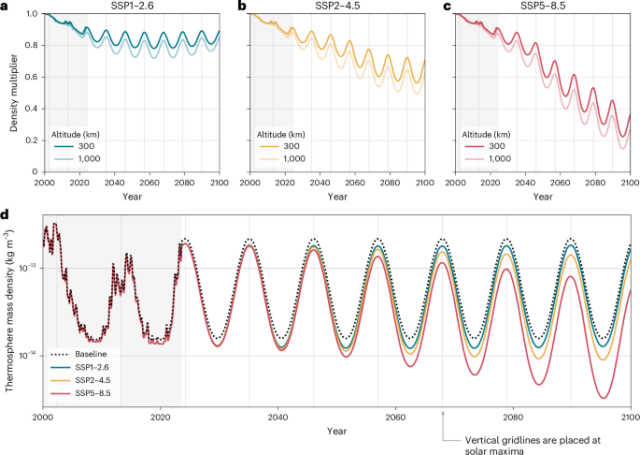Suche
Beiträge, die mit Space getaggt sind
The Da Vinci Glow
apod.nasa.gov/apod/image/2504/…
A 26 hour old Moon poses behind the craggy outline of the Italian Dolomites in this twilight mountain and skyscape. The one second long exposure was captured near moonset on March 30. And while only a a sliver of its sunlit surface is visible, most of the Moon's disk can be seen by earthshine as light reflected from a bright planet Earth illuminates the lunar nearside. Also known as the Moon's ashen glow, a description of earthshine in terms of sunlight reflected by Earth's oceans illuminating the Moon's dark surface was written over 500 years ago by Leonardo da Vinci. Of course earthshine is just the most familiar example of planetshine, the faint illumination of the dark portion of a moon by light reflected from its planet.
Attribution: Giorgia Hofer
@science@lemmy.world @science@beehaw.org @space@beehaw.org @space@lemmy.world @science@lemmy.ml @space@newsmast.community @space@lemmy.ml #space #science #nasa #astronomy
Schon beeindruckend, was der erste (Fehl-)Start einer deutschen Kleinrakete so alles ist und kann. 🤔
#isaraerospace #space #raumfahrt 🚀 💥
A Space Opera – Part 02
William Shatner [feat. Nick Valensi] - Major Tom (Coming Home)
William Fitzsimmons - Ready the Astronaut
Mike Oldfield - Supernova
Jaakko Aukusti - Home (Space Cowboy)
Weltschmertz - Astronaut
PAUL EISEN - WELTRAUMSPAZIERGANG
David Bowie - Starman
Mansionair - Astronaut (Something About Your Love)
Kayleph - M22
Gustav Holst - Neptune, The Mystic
New Orleans - Astral Nebula
Kate Bush - Hello Earth
Yello - Magnetic
Tomita - Uranus, The Magician & Neptune, The Mystic
Nadya Ostroff DR.NO - Little Cosmonaut
Melodicka Bros (feat. PatrickRussellMusic) - A Space Rock Medley
Tomita - Mercury, The Winged Messenger
Peter Thomas Soundorchester - Lonesome Astronaut
#music #space #spacemusic #soundtrack #soundtracks #mixtape #mixtapes
Stereo Helene
apod.nasa.gov/apod/image/2503/…
Get out your red/blue glasses and float next to Helene, small, icy moon of Saturn. Appropriately named, Helene is a Trojan moon, so called because it orbits at a Lagrange point. A Lagrange point is a gravitationally stable position near two massive bodies, in this case Saturn and larger moon Dione. In fact, irregularly shaped ( about 36 by 32 by 30 kilometers) Helene orbits at Dione's leading Lagrange point while brotherly ice moon Polydeuces follows at Dione's trailing Lagrange point. The sharp stereo anaglyph was constructed from two Cassini images captured during a close flyby in 2011. It shows part of the Saturn-facing hemisphere of Helene mottled with craters and gully-like features.
Attribution:
@science@lemmy.world @science@beehaw.org @space@beehaw.org @space@lemmy.world @science@lemmy.ml @space@newsmast.community @space@lemmy.ml #space #science #nasa #astronomy
Messier 81
apod.nasa.gov/apod/image/2503/…
One of the brightest galaxies in planet Earth's sky is similar in size to our Milky Way Galaxy: big, beautiful Messier 81. Also known as NGC 3031 or Bode's galaxy for its 18th century discoverer, this grand spiral can be found toward the northern constellation of Ursa Major, the Great Bear. The sharp, detailed telescopic view reveals M81's bright yellow nucleus, blue spiral arms, pinkish starforming regions, and sweeping cosmic dust lanes. But some dust lanes actually run through the galactic disk (left of center), contrary to other prominent spiral features. The errant dust lanes may be the lingering result of a close encounter between M81 and the nearby galaxy M82 lurking outside of this frame. Scrutiny of variable stars in M81 has yielded a well-determined distance for an external galaxy -- 11.8 million light-years.
Attribution: Lorand Fenyes
@science@lemmy.world @science@beehaw.org @space@beehaw.org @space@lemmy.world @science@lemmy.ml @space@newsmast.community @space@lemmy.ml #space #science #nasa #astronomy
Ancient Ogunquit Beach on Mars
apod.nasa.gov/apod/image/2503/…
This was once a beach -- on ancient Mars. The featured 360-degree panorama, horizontally compressed, was taken in 2017 by the robotic Curiosity rover that explored the red planet. Named Ogunquit Beach after its terrestrial counterpart, evidence shows that at times long ago the area was underwater, while at other times it was at the edge of an ancient lake. The light peak in the central background is the top of Mount Sharp, the central feature in Gale Crater where Curiosity explored. Portions of the dark sands in the foreground were scooped up for analysis. The light colored bedrock is composed of sediment that likely settled at the bottom of the now-dried lakebed. The featured panorama (interactive version here) was created from over 100 images and seemingly signed by the rover on the lower left.
Attribution:
@science@lemmy.world @science@beehaw.org @space@beehaw.org @space@lemmy.world @science@lemmy.ml @space@newsmast.community @space@lemmy.ml #space #science #nasa #astronomy
Fomalhaut, photo by Hubble Telescope.
This stunning image shows the star Fomalhaut and its protoplanetary disk, resembling a fiery eye in space. Fomalhaut is about twice the mass of the Sun and still has a disk of gas and dust, similar to what once surrounded our Sun before planets formed.
More Info: en.wikipedia.org/wiki/Fomalhau…
SuperCam Target on Ma'az
apod.nasa.gov/apod/image/2503/…
What's the sound of one laser zapping? There's no need to consult a Zen master to find out, just listen to the first acoustic recording of laser shots on Mars. On Mars Rover Perseverance mission sol 12 (March 2, 2021) the SuperCam instrument atop the rover's mast zapped a rock dubbed Ma'az 30 times from a range of about 3.1 meters. Its microphone recorded the soft staccato popping sounds of the rapid series of SuperCam laser zaps. Shockwaves created in the thin Martian atmosphere as bits of rock are vaporized by the laser shots make the popping sounds, sounds that offer clues to the physical structure of the target. This SuperCam close-up of the Ma'az target region is 6 centimeters (2.3 inches) across. Ma'az means Mars in the Navajo language.
Attribution:
@science@lemmy.world @science@beehaw.org @space@beehaw.org @space@lemmy.world @science@lemmy.ml @space@newsmast.community @space@lemmy.ml #space #science #nasa #astronomy
"Can we send Trump and Musk there!?!"
- Aure
Oxygen detected in the most distant galaxy ever found
#AureFreePress #News #press #headline #Space #Auregoodnews
U.S. Astronauts Suni Williams, Butch Wilmore, Nick Hague, and Roscosmos Cosmonaut Aleksandr Gorbunov splashed down off the coast of Tallahassee, Florida, in the SpaceX Crew Dragon Freedom Capsule on March 18 at 5:57 PM EST.
Image Credit: NASA
@space@lemmy.world @worldnews@lemmy.ml @ news@lemme.world @world@lemmy.world @space@newsmast.community @space@lemmy.ml #space #science #nasa
Thor's Helmet
Thor not only has his own day (Thursday), but a helmet in the heavens. Popularly called Thor's Helmet, NGC 2359 is a hat-shaped cosmic cloud with wing-like appendages. Heroically sized even for a Norse god, Thor's Helmet is about 30 light-years across.
@science@lemmy.world @science@beehaw.org @space@beehaw.org @space@lemmy.world @science@lemmy.ml @space@newsmast.community @space@lemmy.ml #space #science #nasa #astronomy
Venus and the Triply Ultraviolet Sun
apod.nasa.gov/apod/image/2503/…
@science@lemmy.world @science@beehaw.org @space@beehaw.org @space@lemmy.world @science@lemmy.ml @space@newsmast.community @space@lemmy.ml #space #science #nasa #astronomy
Venus and the Triply Ultraviolet Sun
This was a very unusual type of solar eclipse. Typically, it is the Earth's Moon that eclipses the Sun. In 2012, though, the planet Venus took a turn. Like a solar eclipse by the Moon, the phase of Venus became a continually thinner crescent as Venus became increasingly better aligned with the Sun. Eventually the alignment became perfect and the phase of Venus dropped to zero.
@science@lemmy.world @space@lemmy.world @science@lemmy.ml @space@newsmast.community @space@lemmy.ml #space #science #nasa #astronomy
#Greenhouse gases reduce the #satellite carrying #capacity of low #Earth #orbit
Source: nature.com/articles/s41893-025…
#climate #space #technology #news #problem

Greenhouse gases reduce the satellite carrying capacity of low Earth orbit - Nature Sustainability
Satellites have become integral to our everyday life, but space debris threatens the sustainability of low Earth orbital space.Nature




























